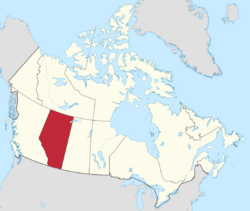List of ghost towns in Alberta facts for kids
The province of Alberta in Canada is home to many ghost towns. These are places that were once busy communities but are now mostly or completely empty. Many of Alberta's ghost towns appeared because coal mining operations, which were very popular in the early 1900s, eventually failed.
A ghost town is like a town that has gone to sleep. It used to have lots of people, homes, and businesses. But then, something big happened that made most people leave. This could be because a main highway or train tracks moved somewhere else, or because a natural resource, like coal, ran out. When people leave, businesses close, and the town becomes quiet and empty.
Contents
What are Ghost Towns?
Why Towns Become Empty
Imagine a busy town where everyone works in a coal mine. If the coal runs out, or if the mine closes for another reason, people lose their jobs. They have to move to find new work. This can make a town shrink very quickly.
Sometimes, a new highway is built that goes around a town instead of through it. This means fewer travelers stop there, and businesses like gas stations and restaurants lose customers. Over time, these businesses might close, and people move away.
Train tracks were also very important. If a railway line was removed or rerouted, towns that depended on the train for supplies or to ship goods would struggle.
Famous Alberta Ghost Towns
Here are some interesting ghost towns in Alberta, each with its own story:
Alexo
Alexo was a coal mining town in Clearwater County. It was once home to 113 people in 1951. When the coal mine closed, most people moved away, leaving the town quiet.
Anthracite
Located in Banff National Park, Anthracite was another coal mining community. In 1911, it had 25 residents. Today, not much is left of this historic mining town.
Bankhead
Also in Banff National Park, Bankhead was a busy coal mining town. In 1911, it had a population of 694 people. The mine closed in 1922, and the town was abandoned.
Cadomin
Cadomin is in Yellowhead County. It was once a large coal mining community, with 1,053 people living there in 1941. While it's much smaller now, with 40 people in 2016, it still has some residents.
Chisholm Mills
Chisholm Mills was a community in the Municipal District of Lesser Slave River No. 124. It had 323 residents in 1941. By 2016, only 25 people remained, showing how much it had shrunk.
East Coulee
Near Drumheller, East Coulee was a thriving town with 1,831 people in 1941. It was a coal mining hub. Today, it's much smaller, with 148 residents in 2016, but still has some life.
Flowerdale
Flowerdale was a settlement in Special Area No. 2. It had a post office, a general store, and a school. However, it was abandoned in the early 1920s and then destroyed by a prairie fire. Not much remains today.
Frank
Frank is famous for the "Frank Slide." In 1903, a massive rockslide from Turtle Mountain buried part of the town. Despite this disaster, the town continued for a while, with 1,178 people in 1906. Today, 85 people still live there, making it a very small community.
Luscar
Luscar was another important coal mining community in Yellowhead County. In 1941, it had 620 residents. Like many mining towns, it became a ghost town when the mines closed.
Mercoal
Also in Yellowhead County, Mercoal was a coal mining town that peaked with 977 people in 1951. It is now mostly abandoned.
Mountain Park
Mountain Park, in Yellowhead County, was a coal mining community nestled in the mountains. It was once a busy place but is now mostly deserted.
Nordegg
Nordegg is a former coal mining town in Clearwater County. It's also a National Historic Site of Canada. In 1951, it had 875 residents. By 1986, only 53 people remained, but its history is preserved.
Rowley
Rowley is a small community in Starland County. It had 76 people in 1951. By 2013, only 8 people lived there, but they have worked to preserve some of the old buildings, making it a unique place to visit.
Wayne
Wayne, near Drumheller, was once home to 601 people in 1941. It was a coal mining town with several bridges crossing the Rosebud River. Today, it's a very small community, but some of its old buildings and bridges still stand.
Images for kids
-
Remains of Flowerdale
-
Hotel in Luscar in the 1950s
-
Sun setting on Maybutt
-
Vacant store in Nemiscam
-
Vacant store in Orion
See also
- List of communities in Alberta
- List of ghost towns in Canada
- List of hamlets in Alberta
- List of localities in Alberta
- List of towns in Alberta
- List of villages in Alberta









